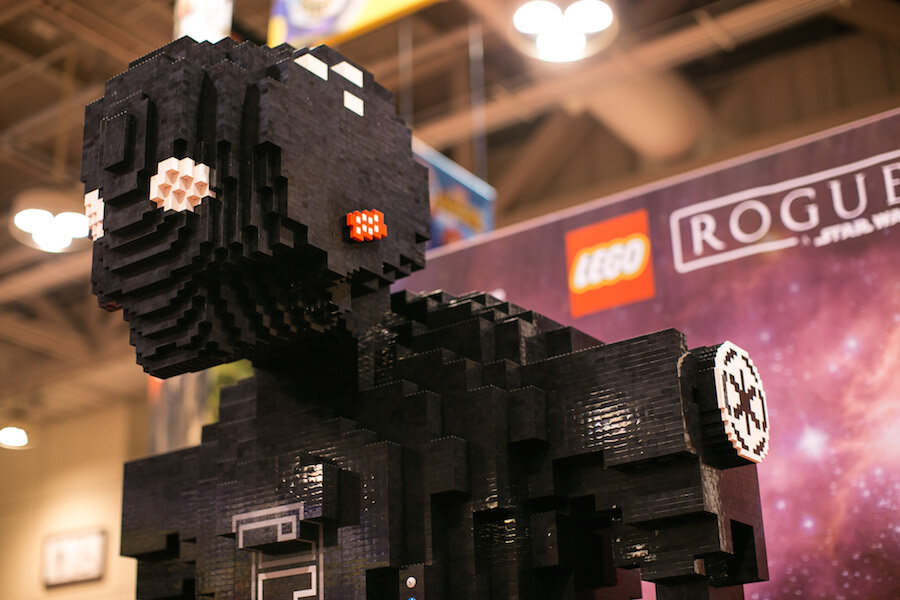How does LEGO thrive in the age of video games? Storytelling.
Loading...
After years of explosive growth and record profits, iconic building-block maker LEGO reported Tuesday that it saw flat sales in North America in the first half of this year. But that's not entirely bad news.
The family-owned Danish toymaker says part of the reason for the sales slump is that it could not meet high demand in the Americas because of problems with its global supply chain, according to the Wall Street Journal. This led the company to invest less in marketing the blocks here.
“In the US, we acknowledge that we have not provided the initiatives and support needed to keep the same high level of growth,” as in Europe and Asia, where sales grew by double-digits so far this year, says the company’s executive vice president and chief financial officer John Goodwin in a statement online.
To adjust, the company says it has bought a new factory in China, expanded production in Mexico, and will double production at its Hungary plant. On top of that, LEGO said it has hired 3,500 workers so far this year, adding to its 18,500 global staff members. All this will help lift North American profit in the second half of 2016, Mr. Goodwin told the Journal.
Despite the slump in some sales so far this year, the company has been growing its annual sales by 21 percent, and annual profit by 36 percent, on average in the last eight years, according to David Robertson, a professor of innovation and product development at Wharton business school. He wrote a book about LEGO, “Brick by Brick,” in 2013.
In the age of video games, apps, and Netflix – and a decade after the company nearly went out of business – the growth is impressive. And it begs the question: How does a half-century-old, rudimentary building-blocks toy still attract so many people?
“LEGO is really good at telling stories around the brick,” says Prof. Robertson. “It learned that you can’t just have a box of bricks.”
The company today makes lines of block sets that revolve around storylines: like those of a set of ninjas who fight evil, called Ninjago, and Legends of Chima, about tribes of anthropomorphic animals. These sets are accompanied by video games, TV shows, action figures, and even a LEGO conference. “You have to think what else besides the brick would get kids involved with the toy,” Robertson explains.
LEGO also has also struck gold with its licensing deals over the years. The company has an exclusive license with Star Wars to make themed brick sets featuring the some world's most popular characters. “If you want to build a Death Star out of plastic blocks, LEGO is now your only option,” NPR’s “Planet Money” reported in 2012.
Through the years, the company has also licensed Indiana Jones, Winnie the Pooh, Toy Story, Harry Potter, Batman, and many others.
More recently, the company has made a successful foray into movies. “The Lego Movie” in 2014 featured popular LEGO characters and helped push the company ahead of Hasbro and Mattel briefly into the spot of #1 toy manufacturer in the world. This, despite the fact that Mattel has Barbie, Hot Wheels, Fisher-Price, and now Lego-like Mega Bloks under its name, as Fast Company points out, while LEGO has only one line of business.
“They’ve got some very strong licenses and a very strong management team and incredibly high brand equity, so all these things maintain them,” says Richard Gottlieb, consultant to the toy industry through his company, Global Toy Experts.
But, says Mr. Gottlieb, LEGO could face some challenges, particularly from competitor Mattel. In 2014 Mattel bought Mega Brands, the Canadian maker of Mega Bloks, “so they can begin eating into Lego sales,” says Gottlieb.
“[Mega Brands] now has Mattel’s power for strong licenses and to promote the products,” he says.
Though LEGO beat its biggest competitor in sales in the first half of last year, it has not exceeded Mattel yet in full-year sales, which include the profitable holiday season, as the Journal reports. Mattel’s sales were also down as of this past July.
Regardless of the dip in toy sales this year, though, Gottlieb says he has faith in Legos.
“Whatever they do, LEGO sustains a certain level of high quality and attention to detail,” he says.
[Editor's Note: LEGO's average annual sales and profit has been updated from the original version.]






